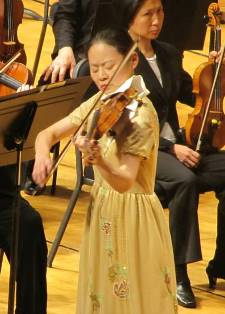
Midori, CSO Luxury Casting
Luxury casting is what Thursday evening’s Cincinnati
Symphony Orchestra concert was all about.

Not only was violinist Midori the featured artist in Shostakovich’s Violin Concerto No. 1 in A Minor, but the CSO – 98-strong, including a fortified brass section – was center stage for an Orchestra Suite from Wagner’s operatic “Ring” cycle (as opposed to a smaller orchestra in the pit).
Rarely, has Music Hall been so filled with glorious sound.
On the podium was guest conductor Jun Märkl, a master of the German repertoire, who led a stunning performance of his own arrangement of the Wagner Suite.
The first half of the concert was Midori’s, however, and she delivered with total artistry.
Shostakovich’s First Violin Concerto, a serious work written in 1947-48 -- during the era of Stalinist artistic repression when “seriousness” was condemned (Shostakovich withheld it from publication until after Stalin's death) -- is a prime example of the composer’s ability to express in music what could never be expressed in words. There is gravity, irony, banter and drama, all of which Midori conveyed with dazzling virtuosity.
Her delivery of the solemn opening Nocturne was exquisite, a statement complete in its textural and timbral variety, from the softest stroke of the bow to the purest-toned expression, for an effect of profound sorrow. The contrasting Scherzo was a romp, with its thumb-nosing repetitions of Shostakovich’s encoded signature D-E-flat-C-B (which spells “DSCH” in German).
Midori filled the Passacaglia, the emotional centerpiece of the work, with turbulence and passion, including its daunting cadenza. The final Burlesque, a brilliant Presto movement with a somewhat brighter outlook, demonstrated her dexterity as she skittered over the violin, top to bottom. In all of this, she was fully supported by Märkl and the CSO for a performance of brilliance and insight. Audience response was wholehearted and prolonged, and there were repeated curtain calls.
Wagner’s “Ring” music -- from his operatic tetralogy, “Der Ring des Nibelungen,” or “The Ring of the Nibelung” -- is universal in its reach, from the opera house to cartoons, advertisements and film scores (such as “Apocalypse Now”). The orchestra was central to Wagner’s compositional technique, providing the storytelling “motifs” that give his music dramas their shape. For this reason, the orchestra can virtually stand alone in bringing them to the stage.
Märkl’s Suite began with the very first note of the cycle, a low E-flat sounded by the double basses (from the first opera “Das Rheingold," “The Rhine Gold”). From here, the harmony moved up through the horns and made a sudden transition to a mine in the land of the dwarves (“Nibelungs”), whom Alberich, after stealing gold from the Rhine Maidens and forging it into an all-powerful Ring, has enslaved. This excerpt, with the dwarves mining furiously, was made super-vivid by three percussionists striking anvils.
The second opera, “Die Walküre” (“The Valkyrie”), follows the theft of the Ring from Alberich by Wotan, kind of the gods, who gives it as payment to a pair of giants for building his castle Valhalla. Heard here was the ubiquitous “Ride of the Valkyries,” a brassy delight (eight horns with four doubling on Wagner tuba), followed by “Wotan’s Farewell and Magic Fire Music,” the most moving portion of the entire “Ring.” In it, Wotan makes his daughter Brünnhilde (the Valkyrie of the title) mortal as punishment for disobeying him and places her on a rock surrounded by magic fire so that she can be rescued only by a heroic mortal.
The dragon Fafner, current owner of the Ring, appears in “Siegfried,” wherein Siegfried (Wotan’s mortal son, whom he intends to claim both Brünnhilde and the Ring) kills him and takes possession. This menacing excerpt gave way to scenes from the final opera, “Götterdämmerung” (“Twilight of the Gods”), the longest portion of Märkl’s Suite. “Dawn and Siegfried’s Rhine Journey” was filled with vivid color and the pervasive heroism of the Siegfried figure.
This was followed by the tragic close of the cycle (Siegfried is murdered by Alberich’s vengeful son). Slicing right through the hall was “Siegfried’s Death and Funeral Music,” where the Wagner tubas really underlined the fabric. The final excerpt, “Brünnhilde’s Immolation” followed after a sudden transition. Here Brünnhilde, who has, in fact, been rescued by Siegfried and fallen in love with him, throws herself on his funeral pyre and returns the Ring to the Rhine Maidens. This brought the Suite to a magnificent, full-voiced conclusion, crowned by Wagner’s “Redemption by love” theme.
The concert repeats at 8 p.m. Saturday and 2 p.m. Sunday at Music Hall. Tickets begin at $12, available at (513) 381-3300, or visit www.cincinnatisymphony.org